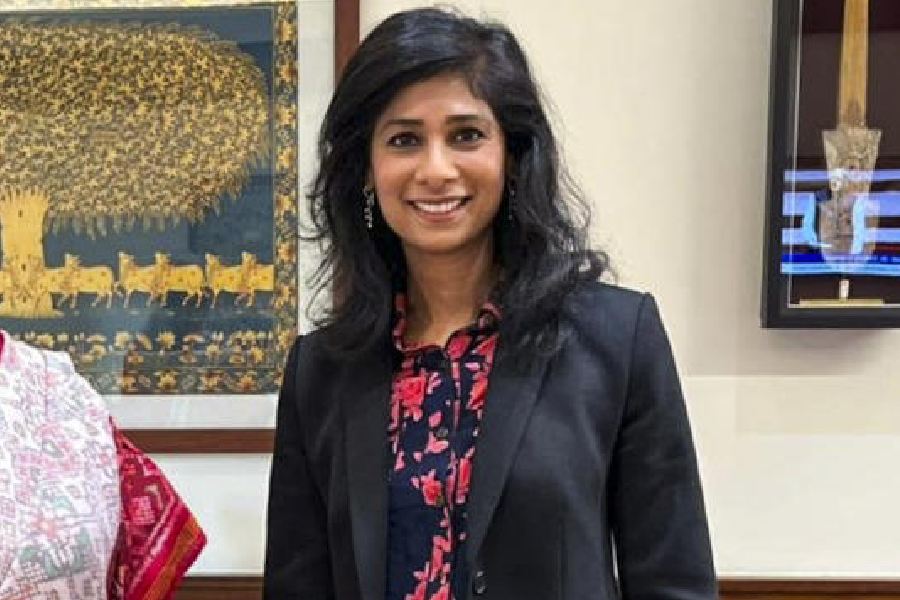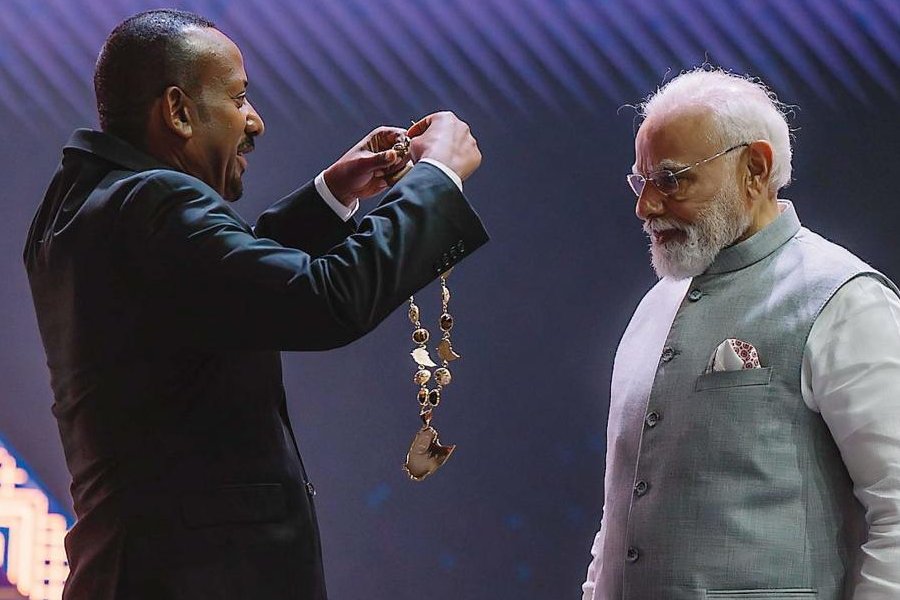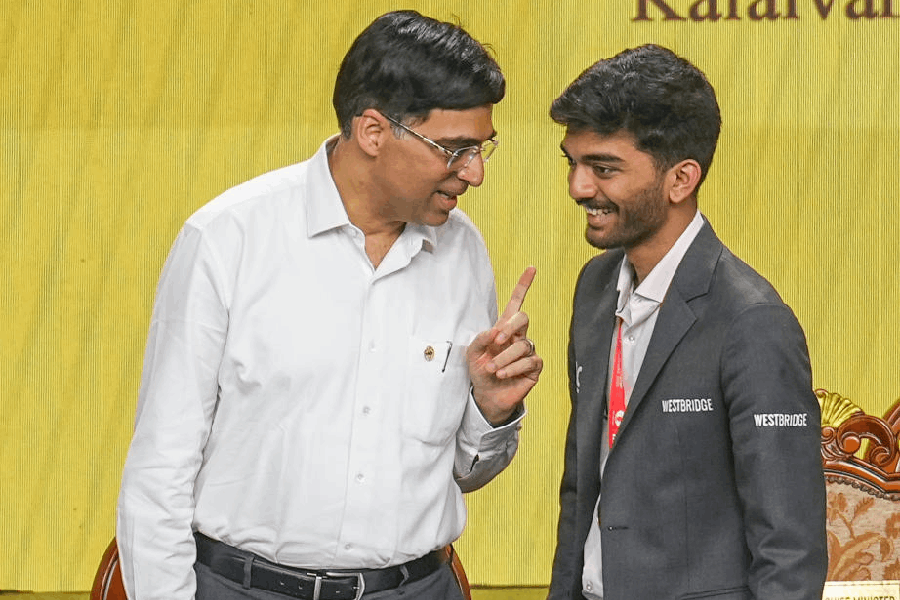 |
| QUALITY QUESTION: IIM, Rohtak, housed in a rented building and (below) its director P. Rameshan. Pictures by Prem Singh |
 |
Professor P. Rameshan has little time in hand. He is busy sorting out applications for faculty positions at his institute. Short-listing candidates is not an easy job. “It’s tough to find trained faculty with a research inclination,” says the director of the Indian Institute of Management (IIM), Rohtak.
At another management institute, the corridors are abuzz with a festive spirit. IIM, Calcutta, the oldest of the 13 IIMs in the country, is now in its golden jubilee year and has carefully laid out plans for celebrations culminating in November 2012.
The two IIMs — one in its infancy and another a ripe 50 — represent the state of management education in India today. If one is finding it hard to get a strong footing, the other is thriving, and basking in the glory of its laurels.
When the central government announced its decision to open seven more IIMs in 2008, it set rolling an ambitious plan, without paying much heed to critics. With only one in every 100 applicants making it into an IIM — the ratio is 1:10 in an American Ivy League school — the government went with the view that quantity wouldn’t mar quality.
“For India’s gross domestic product (GDP) to grow by 8 per cent a year, the country needs about 1.80 lakh junior managers every year,” says .R.S. Rao, director, Cygnus Business and Consultancy Research, Hyderabad. The number of seats at all the IIMs together is only about 2,800 — or 1.4 per cent of the demand. “So there is a need for more quality business schools,” adds Rao.
Yet three years down the line it’s still debatable whether opening these many institutions would help bridge the gap — or widen the space between the older IIMs and the younger ones.
“The question is not whether we need so many IIMs, but whether we have the resources to run institutions of higher education that can compete for international excellence,” says S.L. Rao, former president of the All India Management Association and former director general of the New Delhi-based National Council for Applied Economic Research.
| THE LEADERS |
| IIM Calcutta Started in: 1961 Campus: Permanent Student-teacher ratio: 9:1 Placement: No. of students – 388; No. of offers – 464 IIM Bangalore Started in: 1973 Campus: Permanent Student-teacher ratio: 11:1 Placement: No. of students – 332; No. of offers – 461 IIM Lucknow Started in: 1984 Campus: Permanent Student-teacher ratio: 6:1 Placement: No. of students: 366; No. of offers 528 |
| THE YOUNG GUNS |
| IIM Shillong Started in: 2008 Campus: Permanent Student-teacher ratio: 5:1 Placement: No. of students: 66; No. of offers: 68 IIM Ranchi Started in: 2010 Campus: Temporary Student-teacher ratio: 20:1 Placement: Not applicable (students yet to pass out) IIM Kashipur Started in: 2011 Campus: Temporary Student-teacher ratio: No. of students – 38; No permanent faculty as yet Placement: N.A. |
| NB: All placements are 2011 figures. The list is not exhaustive |
Remote locations, faculty crunch and corporate obscurity are just a few of the many problems the new IIMs face.
“Currently we have six permanent faculty members. Of the total 50 courses, close to 30 are taught by visiting faculty drawn from IIM, Calcutta, and other places,” says M.J. Xavier, director, IIM, Ranchi.
Almost every director of the new IIMs reiterates this point — that they are just not enough teachers. IIM, Kashipur, in Uttaranchal, at present mentored by IIM, Lucknow, is still looking for a director.
Each of these seven new IIMs, now running on rented premises, is to move to its own campus in two or three years. “We pay a rent of Rs 2 crore to the Mahirishi Dayanand University annually. This is almost half of the grant that we receive from the government,” rues Rameshan. Not having a permanent campus also leads to infrastructural limitations.
IIM, Shillong, called the Rajiv Gandhi Indian Institute of Management, was the first to start functioning in 2008 with 64 students. The present batch has 106 students. Since its inception, the institute has been facing flak for failing to retain faculty and corporate reluctance to travel to hilly terrains to offer placements, among other issues.
“Several teachers from IIM, Shillong, have taken up jobs at other IIMs,” says the director of an IIM on the condition of anonymity. It has been reported that seven of the 13 permanent faculty members moved out within the first year of joining the institute. After repeated attempts by The Telegraph to contact the director, an official replied: “The director has asked you to send the queries to the ministry of human resource and development (MHRD).”
The ministry is insouciant. “The growth of new IIMs would depend on the leadership of the institutes and unfortunately Shillong is facing some problems,” says a senior MHRD official. “But these are birth pangs and would be over soon.”
Not everybody endorses the ministry’s optimistic view. Rao is particularly critical. “What was the need for an IIM in Shillong? Students from that part could easily travel to Calcutta if seat numbers were increased,” he says. “You must not forget that faculty members who join an IIM have to shift with their family. So having IIMs without proper housing and schooling facilities would act as a dampener for many.”
When the IIMs were being planned, policymakers decided to set them up at industrial hubs. IIM, Ahmedabad, was close to a textile centre, the jute industry led to the Calcutta IIM, and IIM, Bangalore, came up in a place that was to become an IT hub. “Industry interface is absolutely necessary for a student of management. An IT institute can be set up in a remote area but not a management institute,” says Premchand Palety, CEO of Centre for Forecasting and Research (C-Fore), which conducts annual B-school surveys.
The spurt in IIMs has been causing problems for some of the older institutes too. Since hiring the right kind of faculty is a difficult task, the newer IIMs are seeking to woo teachers and administrators — often from the older IIMs — with plum positions and attractive packages. “This is natural progression. I have over 15 years of experience,” says Rameshan, who was first at IIM, Lucknow, then at IIM, Kozhikode, and now heads IIM, Rohtak.
One problem is the preference that IIMs give to old boys when it comes to hiring directors because non-IIM graduates, it is argued, may have problems adapting to an IIM set-up. An IIM, Kozhikode, director not from the IIMs had to resign in over a year’s time because of, insiders believe, resentment from within the institution. “No international school of repute looks for a director from within itself,” says Nirmalaya Kumar, professor of marketing, co-director, Aditya Birla Centre, London Business School.
 |
| FLYING COLOURS: A file picture of students at IIM, Calcutta, after their convocation |
What is more, companies are taking a cautious approach to the new institutions. “We would definitely be concerned about the intake to maintain quality,” says Ravishankar B., senior vice-president, human resources (core software), HCL Technologies Ltd, Noida. “There will be a difference in the salaries too as the CAT score is lowered for students at the new institutes,” adds Ravishankar.
The so-called dilution of the brand is creating unrest among the student community as well. “We have had many students at our institute who chose other B-schools such as the SP Jain Institute of Management Research, Mumbai, XLRI, Jamshedpur, Faculty of Management Studies, Delhi, and Management Development Institute, Gurgaon, over the new IIMs,” says Rahul Reddy, managing director of the Calcutta division of T.I.M.E, a preparatory institute. “It’s because many believe they would get better faculty and recruiters in these institutes than in the newer IIMs,” adds Palety.
Nishita Tibrewal from Calcutta with a 97.2 percentile in CAT 2011 is a case in point. She got a seat at one of the newer IIMs, but chose to join another B-school. “I took this decision after speaking to many people from industry,” says Tibrewal.
Not everyone, though, is worried. Gautam Puri, vice-chairman and managing director, CL Educate Ltd, an education firm, stresses that more IIMs mean more employable managers. E. Balaji, managing director and chief executive officer, Ma Foi Randstad, the human resources company, believes the new IIMs will take time to mature. “They will have to go through the process of trial and error before they come of age,” says Balaji.
Though the IIMs were recently criticised by Infosys founder Narayana Murthy and rural development minister Jairam Ramesh, who said the institutes had failed to gain international recognition over the years, the schools have generally been held up in India as centres of academic excellence.
But the institutions — which started in November 1961, when the first national institute for postgraduate studies and research in management was set up in Calcutta by the government in collaboration with the MIT Sloan School of Management — find no place in international rankings when it comes to research.
“Doesn’t it reflect poorly on our institutions of excellence that in our golden jubilee year we have little to show apart from creating managers for the market,” asks Rao.
Educationists believe the focus of the faculty in many cases is on consultancy, which takes away time from research. The salary of an IIM faculty member is between Rs 65,000 and Rs 95,000 a month, whereas a consultant can earn up to Rs 40,000 for just a day’s session.
For the younger IIMs, however, the problems are more immediate. “I have been asking for a common group discussion and personal interview (GD-PI) process for selection of students. This would save us time and resources, but none of the older institutions is agreeing,” says Rameshan. “It’s a stressful process for a student who has to appear for seven to eight GD-PI for every IIM that he has been selected for,” Rameshan argues.
Vacant seats at some new IIMs too have evoked concern. “The new IIMs will now have a common counselling and interview process. This will help in filling up seats,” says an MHRD official.
According to Devi Singh, director, IIM, Lucknow, the problems arose because too many IIMs came up together. “We kept a gap of a few years between IIM, Kozhikode, and IIM, Indore. But this time around, all of them have started together,” says Singh. “But it won’t have any effect on the IIM brand. These new institutes too will make a mark soon,” he adds.
How soon is the question on everyone’s lips. And there are no immediate answers.
and










